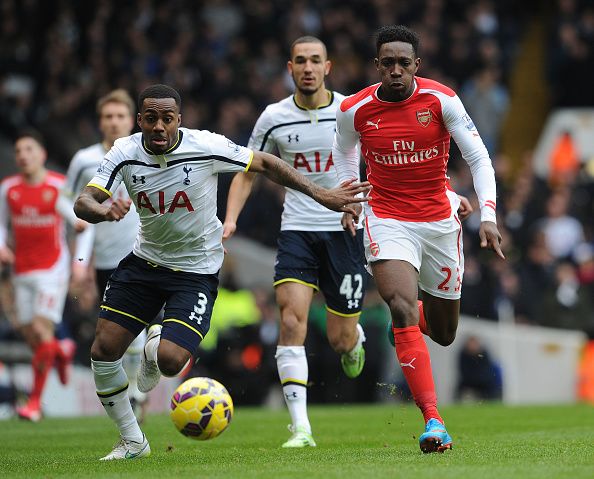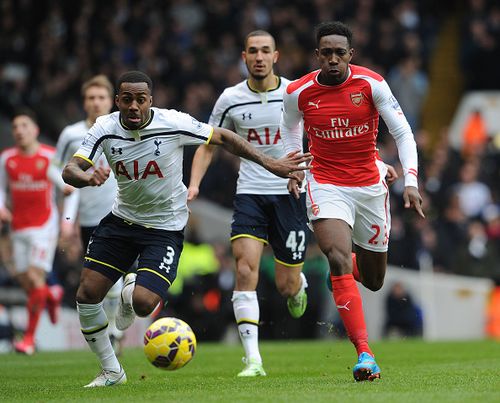
Tottenham 2-1 Arsenal: Tactical analysis - Gunners sit back and concede midfield battle

Harry Kane carried the weight of expectations that the Tottenham Hotspur fans and management had put in him and delivered yet another victory in a London derby. Arsenal looked set for yet another victory after the early Mesut Ozil goal but were undone by the commitment and perseverance of Spurs as the home team attacked relentlessly to secure a memorable victory.
Starting Lineups
Tottenham Hotspurs (4-2-3-1): Lloris – Walker, Dier, Vertonghen, Rose – Bentaleb, Mason – Lamela, Dembele, Eriksen – Kane
Arsenal (4-3-3): Ospina – Bellerin, Mertesacker, Koscielny, Monreal – Coquelin, Ramsey, Cazorla – Ozil, Giroud, Welbeck
First Half
Arsene Wenger set his team up in a 4-3-3 formation with Francis Coquelin sitting deep in midfield, covering his defence. Cazorla and Ramsey completed the midfield trio, with Cazorla positioned surprisingly deeper than Ramsey. Ozil started on the left wing while Welbeck was on the opposite wing. This shape with Coquelin as the defensive midfielder gave Wenger a well-earned win against Manchester City, and the same was expected here at White Hart Lane.

Spurs were lined up in their usual 4-2-3-1 shape with Dembele in the No.10 position with Lamela and Eriksen completing the attacking band behind the striker Harry Kane. Nabil Bentaleb, who returned from international duty slotted right into the midfield alongside Ryan Mason. Both teams were playing with a lone striker, which usually allows a lot of scope for direct play or wing play. On paper, both the midfield triangles matched each other, but on the pitch it was a different scenario.
Arsenal allow Spurs to have the ball and try to play on the break
As expected, the visitors chose to set themselves up in a medium block, and try to take Spurs on in quick counters. Giroud, the highest Arsenal man was almost on the half way line and was the only one pressing the Spurs backline, albeit without much success. Vertonghen and Dier had loads of time on the ball to pick out passes in every direction. This meant that the Spurs fullbacks pushed high up the pitch, leaving huge chunks of space behind them. Danny Rose especially was very adventurous on the Spurs’ left flank.

In the opening minutes, the tempo of the play saw both teams attack each other with direct runs on the flanks. Spurs were the first to get a shot on target when Dembele launched a counter attack from Arsenal’s left side as both Monreal and Cazorla were caught high up the pitch. Harry Kane’s shot was well saved by Ospina. The Arsenal defense were caught in two minds on their positioning, when they had the ball in advanced positions. Their initial plan was to stay compact and deep, but when they broke forward, Harry Kane had all the license to run behind them and invite quick long balls from his midfielders.

But against the run of play, Arsenal opening the scoring with Mesut Ozil after Welbeck left Rose on his heels and carried the ball into the Spurs’ box. Vertonghen was caught high up the pitch, and Walker had to cover for him, leaving Ozil free to slot into the goal. With the midfield matching the numbers, the only possible route of offense was from wide positions.
Eriksen pulls players onto him, Rose gets free license
After the goal, the visitors chose to sit deep and defend, and this played into the hands of Spurs, as they came at Arsenal with all guns blazing. Christian Eriksen was the man in focus as he pulled the Arsenal players out of position with ease. Bellerin especially followed the Dane infield and exposed the whole of his flank. This allowed Danny Rose to bomb forward at will, and he had two very good chances at goal as a result of it.
The following chalkboard shows the passes received by Rose on the left flank. The two light blue arrows are the passes he received after which he took a shot on Arsenal goal. The graphic also depicts how advanced and adventurous Rose was with his positioning.

Both Eriksen and Kane’s off the ball movement overloaded Arsenal’s midfield. And Coquelin’s deep positioning allowed space for Dembele to operate in. Also, another inverted in Erik Lamela squeezed the play even more as Spurs kept foreseeing wave after wave of attacks.
Rose’s freedom on his flank saw Wenger instructing Danny Welbeck to be more active defensively. But the former United man was probably too exciting with the new orders, as he clattered Rose with a late challenge and earning a yellow card. Both teams tried to attack from this flank and were mostly succeeding to get into their respective attacking thirds.
Welbeck shows his defensive side, Arsenal sit back while Mason and Bentaleb dominate
Following Danny Rose’s attacking surges, Arsenal tightened their defence and got organized in midfield. Welbeck stuck tight to Rose and Giroud was the only man pressing Spurs’ defence. Even then, the home team found pockets of space and had chances on few counters, but some bad passing choices from Lamela and Eriksen in advanced positions.
Ryan Mason and Nabil Bentaleb marshaled the midfield with ease as neither Ramsey nor Cazorla got tight to them. The following heatmap shows the number of touched they had in the middle of the park, especially in the Arsenal half.

This dominance in the centre of the park is only helpful if the next band of players continue the tempo in attack. But Eriksen and Lamela ran into red shirts whole were resolute in their positional discipline. This allowed Arsenal some leeway as they were able to see out the half without much fuss. Spurs though, were the ones who ended the half on a high.
Second Half
Both managers didn’t make any changes during the break, and the second half started very similar to the first half. Both teams tried to get into the final third with urgency, but neither were successful in getting a goal. After the initial high tempo game faded into a more patient passing one for Spurs, Harry Kane found the equalizer courtesy of a corner.
The build up to that corner saw Arsenal’s midfield bypassed easily as Ryan Mason got into space and had a shot deflected behind for the corner. Arsenal could have still dealt with the set piece, but they failed to mark Kane on the far post and paid the price, after two concentration lapses.
Arsenal don’t change their style, Spurs’ attackers find their form
The equalizer from Kane didn’t force any immediate response from Wenger to change things. But the goal surely brought the confindence of the home team back as Eriksen started playing with real intent. Santi Cazorla was having a bad day as he was outrun easily by Dembele on numerous occasions. The above image shows the areas in which Dembele received passes. Almost every pass Dembele received was in front of Coquelin or behind Cazorla, which often forced either Koscielny or Monreal to step out of defense and pressure the Belgian.

Cazorla was replaced by a more flairy Rosicky, probably to push Ramsey into a more defensive role. The substitution should have encouraged Erik Lamela to attack more, but the Argentinian was Spurs’ worst player of the match as he repeatedly conceded possession and made bad passing choices. Despite Lamela’s ineffectiveness in the attacking third, Spurs had very good spells of dominance, with crosses flying in and corner being won consistently.
The following image depicts how dominant Spurs were in their attacking third. Arsenal had less than a third of the shots Spurs had and their only shot on target was Ozil’s goal.

Pochettino brought on Nacer Chadli for Dembele. Chadli slotted into the left wing position as Eriksen became a No.10. This move from Pochettino meant that Spurs now had a defensively sound left flank. Wenger replaced Welbeck with Walcott, and it seemed that Arsenal might bring out their attacking self, but they still maintained their counter-attacking philosophy.
Walcott operated more centrally as Giroud drifted into channels. The attacking move didn’t have much impact as Walcott touched the ball only 5 times in the 17 minutes he was on the pitch.
Kane rises to the occasion, Wenger fails with his changes
In contrast to the night against Chelsea, Harry Kane was relatively quiet. He had a few good runs behind the Arsenal defence in the first half and had a shot saved. The towering presence of Mertesacker did put Kane off his game a bit, compared to the easy outing he had against Gary Cahill. The second half was a bit better as he linked up well with Eriksen and showed intelligence in peeling away from defenders at the far post for his first goal.
The young striker put Spurs ahead with a beautiful header thanks to a cross from deep by Bentaleb. It was a goal out of nothing and Koscielny could have done better by challenging Kane in the air. It was not a great performance overall by Kane, but he delivered when his team needed him to.
The following chalkboard shows the touches of Harry Kane for the whole 90 minutes. One can observe his constant movement to find himself in space and provide an option for a pass. Also, Arsenal’s deep defense meant that Kane very few touches inside the Gunners’ box.

The next chalkboard displays the offsides called for Harry Kane. As discussed earlier, Kane tried to get behind the Arsenal defense whenever they pushed up, and most of the time they were wary of Kane’s runs behind them.

Arsene Wenger was lauded for his change of tactics against Manchester City, and that approach was understandable as City are one of the strongest teams in England. But using the same template against Spurs will surely be questioned, as he could have easily gone back to his usual brand of attacking football and hit the opponent hard from the start.
The defensive approach worked to an extent, but Kane’s equalizer should have been the trigger for a change to an attacking style. His changes reflected this intent, but his team were not equipped to handle such change in tactics mid-game. Arsenal players couldn’t pick their game up to combat the attacking waves of Spurs, and they will have to work on their in-game tactical transitions if they want to continue employing a defence first approach in away games.